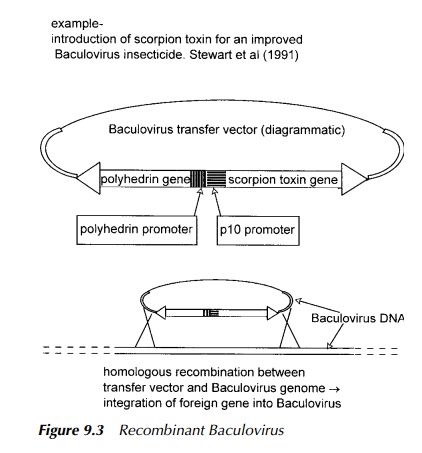Chapter: Environmental Biotechnology: Genetic Manipulation
Analysis of Recombinants: Bacteria, Yeast, Viruses
Analysis of Recombinants
The design of the plasmid was such that insertion of ‘foreign’ DNA allows for a colour test, or causes a change in antibiotic sensitivity, either to resistance (positive selection) or sensitivity (negative selection). This constitutes the first step in screening. The second stage is usually to probe for the desired gene using molecules which will recognise it and to which is attached some sort of tag, usually radioactive or one able to produce a colour change. The next stage is normally to analyse the DNA isolated from possible recombinants, firstly by checking the size of the molecule or pieces thereof, or by sequencing the DNA. This is the most informative approach but used to be very laborious. With the current and ever-developing automated protocols, DNA sequencing has become a standard part of recombinant analysis procedure. However, if a large number of samples are to be analysed it is usually quicker and cheaper to scan them by a procedure described as a Southern blot, after Ed Southern, the scientist who designed the technique.
In this procedure, the DNA is spread out by electrophoresis on a gel which is then probed by a piece of radioactive DNA complementary to the sequence of interest. If a band shows up on autoradiography then the probe has found a mate and the required sequences are present, at least in part. DNA sequencing is then required to confirm exactly what has occurred during the cloning procedure but the advantage is that only the samples which are very likely to contain the required insert are sequenced, thus saving time and expense.
From this technique, has developed the Northern blot which is much the same idea except that the material spread out on the gel is RNA rather than DNA, and the Western blot which is slightly different in that the material electrophoresed is protein, which is probed with antibodies against the anticipated protein, rather than nucleic acid, as is the case in Southern and Northern blots.
Recombinant Bacteria
Genetic engineering of micro-organisms for use in environmental biotechnology has tended to focus on the expansion of metabolic pathways either to modify the existent metabolic capability or to introduce new pathways. This has various applications, from the improved degradation of contaminants, to the production of enzymes for industry, thus making a process less damaging to the environment. One such experimental example taken from ‘clean technology’ with potential for the manufacturing industry, is a strain of Eschericia coli into which was engineered some 15 genes originating from Pseudomonas. These were introduced to construct a pathway able to produce indigo for the dyeing of denim, commented on by Bialy (1997). The traditional method requires the use of toxic chemicals with the associated safety measures and inherent pollution problems. Similar technologies were investigated in the early 1980s, by Amgen in the USA and Zeneca in the UK, but were not pursued due to questionable profitability. Whether or not this route will now be taken up by industry remains to be seen (BMB 1995).
Recombinant Yeast
Yeast, being unicellular eukaryotes, has become popular for cloning and express-ing eukaryotic genes. These are fairly simple to propagate, some species being amenable to culture in much the same way as bacteria. Yeast cells are surrounded by a thick cell wall which must be removed to permit entry of DNA into the cell. There are several types of plasmid vector available for genetic engineer-ing, some of which have been constructed to allow replication in both bacteria and yeast (Beggs 1981). All have a region which permits integration into the host yeast genome by recombination. This occurs by alignment of the sequences complementary between the host genome and the incoming plasmid DNA. Two crossover events then take place which effectively swap over a piece of host DNA with the plasmid DNA. A similar process occurs in the construction of recombinant Baculoviruses.
Recombinant Viruses
The insect virus, Baculovirus, has been shown to be the method of choice for the overexpression of genes in many applications of molecular biology. The viral genome is large relative to bacterial plasmids and so DNA manipulations are nor-mally carried out on a plasmid maintained in Eschericia coli. Introduction of the reconstructed gene, or group of genes, to the Baculovirus DNA occurs by recom-bination in much the same way as described for the formation of recombinant yeast. One example of interest to environmental biotechnology is the replacement of p10, one of the two major Baculovirus proteins, polyhedrin being the other, by the gene for a scorpion neurotoxin, with a view to improving the insecticidal qualities of the virus, sketched in Figure 9.3 (Stewart et al. 1991). The ‘promot-ers’ at the start of the gene, referred to in the figure, are the regions of RNA which regulate protein synthesis, from none at all, to maximum expression.

Related Topics